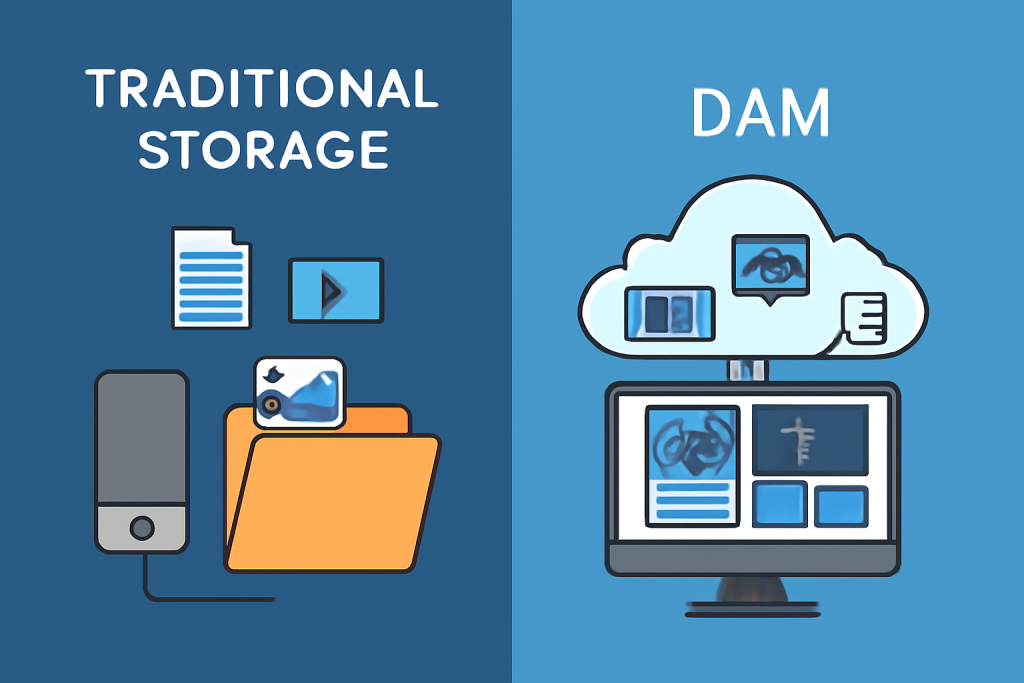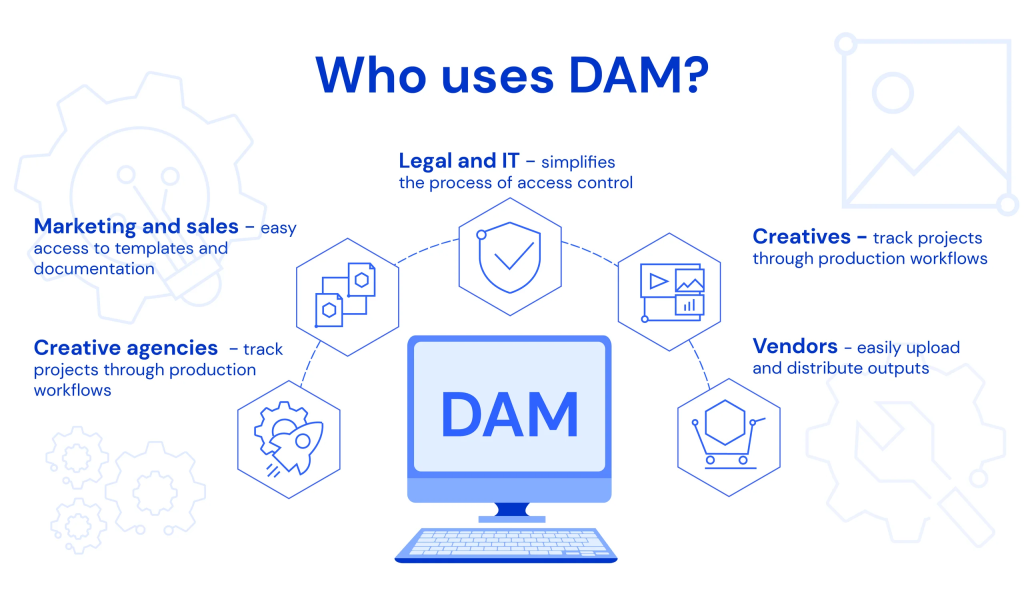
As businesses grow, so do the volumes of digital assets they produce. From marketing materials like images and videos to documentation and product designs, these assets are crucial for business operations. However, managing these assets becomes increasingly challenging as the volume increases. Traditionally, businesses have relied on local storage systems such as hard drives, shared network drives, or cloud storage services. But as the complexity and size of digital content libraries grow, these methods often fall short. Enter Digital Asset Management (DAM) systems—an innovative solution designed to streamline the process of storing, organizing, and retrieving digital assets.
In this blog, we’ll explore the differences between traditional storage methods and DAM solutions, highlighting how DAM systems, like Wizbrand’s DAM software, can support your growing digital content needs more efficiently. We’ll also examine why DAM might be the better choice for businesses aiming to improve collaboration, speed, and overall content management.
What is Traditional Storage?
Traditional storage systems typically refer to methods of storing files on physical hardware (such as external hard drives or on-premises servers) or in generic cloud-based storage services like Google Drive or Dropbox. These systems offer a simple and low-cost solution for storing digital files, and they have been widely used by businesses for years.
However, traditional storage systems often fail to meet the needs of businesses managing large, dynamic content libraries. They typically lack the advanced organizational features required to keep track of assets as they scale. With file systems organized in folders and subfolders, locating assets becomes more challenging over time as file libraries grow.
The Challenges of Traditional Storage
While traditional storage solutions are cost-effective and easy to use, they come with several limitations that can hinder business growth:
1. Limited Organization and Search Capabilities
Traditional storage systems are based on a simple folder structure, which can become cumbersome as the number of assets grows. Without advanced search features or metadata management, finding the right asset among thousands of files can be time-consuming and frustrating. This inefficiency becomes more pronounced as the volume of digital content continues to rise.
2. Collaboration Difficulties
In a traditional storage system, files are typically stored in a shared location where multiple users can access them. However, collaboration on digital assets—especially across different departments or teams—can be inefficient. There’s no central system for reviewing, commenting, or providing feedback on assets. This results in scattered communication, leading to confusion, errors, and delays.
3. Lack of Version Control
Managing multiple versions of the same asset can be problematic in traditional storage systems. Without version control features, teams often struggle to track changes, leading to the use of outdated or incorrect versions of assets. This issue is particularly troublesome when multiple team members are involved in editing or reviewing content.
4. Security and Permissions Issues
Traditional storage systems can also lack granular permission controls, which can lead to security risks. Sensitive files may be accessible to users who shouldn’t have access, increasing the risk of data breaches. Without a clear system for managing permissions, businesses can find it challenging to maintain control over who can view, edit, or share assets.
What is Digital Asset Management (DAM)?

Digital Asset Management (DAM) is a specialized software system designed to centralize the management of digital assets. A DAM system provides tools for organizing, tagging, searching, and retrieving assets efficiently. It goes beyond the basic file storage functions of traditional systems, offering advanced features such as metadata management, version control, and user permissions.
DAM software, like Wizbrand, is purpose-built to handle the complexity of modern digital workflows. It allows businesses to store and organize their assets in a way that facilitates easier access, faster collaboration, and better overall management of content.
The Advantages of DAM over Traditional Storage
While traditional storage solutions serve basic functions, DAM systems offer a comprehensive solution that is better suited to the needs of growing businesses. Here are the key benefits of using DAM software like Wizbrand:
1. Advanced Search and Organization
A major advantage of DAM systems is their ability to efficiently organize and categorize digital assets. With metadata, keywords, and tags, assets can be indexed and easily searched. DAM platforms also allow for hierarchical categorization, meaning assets are sorted in a way that makes sense for your team, whether by project, department, or content type.
Wizbrand’s DAM solution enhances this with intuitive search functionalities, making it faster for your team to find the right asset when needed. This eliminates the need for manual search and improves efficiency across the board.
2. Enhanced Collaboration
DAM systems, such as Wizbrand, are designed for collaboration. With features like real-time sharing, commenting, and feedback tools, teams can work together seamlessly, regardless of location. Whether it’s a marketing team working on a new campaign or a design team refining assets, DAM systems allow for smoother, more efficient collaboration.
With SEO Management Software integrated into the system, Wizbrand enables marketers to optimize assets while collaborating on projects, ensuring that digital content is not only easily accessible but also optimized for search engines.
3. Version Control
One of the key features of DAM software is version control. Unlike traditional storage systems where multiple versions of the same file can cause confusion, a DAM system automatically tracks and manages different versions of digital assets. This means that teams can always access the latest version of an asset and see a complete history of edits and revisions.
With Wizbrand’s DAM platform, your team won’t have to worry about accidentally using outdated content. All assets are versioned and stored in a way that provides full transparency and control.
4. Security and Permissions Management
In traditional storage systems, setting up granular access controls can be challenging. DAM software, however, offers robust security features, allowing businesses to assign specific user roles and permissions. This ensures that sensitive assets are only accessible to authorized individuals, reducing the risk of data breaches.
Wizbrand provides customizable permissions and access controls, allowing businesses to ensure that the right people have access to the right files while maintaining the security and confidentiality of other assets.
5. Scalability and Flexibility
As your business grows, so will your digital content. Traditional storage systems struggle to scale efficiently to handle large volumes of assets. A DAM system, on the other hand, is built to scale with your business, allowing you to organize and store more assets without compromising on accessibility or performance.
Wizbrand’s DAM solution grows with your business, offering the scalability and flexibility needed to manage an expanding content library without the headaches associated with traditional storage methods.
Why Choose Wizbrand?
Wizbrand offers one of the Best Digital Asset Management Software solutions available, designed to help businesses streamline workflows, improve collaboration, and manage growing content libraries. With powerful features like advanced search, version control, and security, Wizbrand’s DAM software stands out as one of the Best DAM Tools in the world for businesses looking to scale and optimize their digital asset management processes.

Conclusion
As your business grows and your digital assets accumulate, it becomes clear that traditional storage solutions are no longer enough. A Digital Asset Management system offers numerous advantages, from advanced search capabilities to improved collaboration and version control. Wizbrand’s DAM solution provides a comprehensive platform that helps businesses manage their content more effectively, ensuring that your team stays organized, productive, and secure.